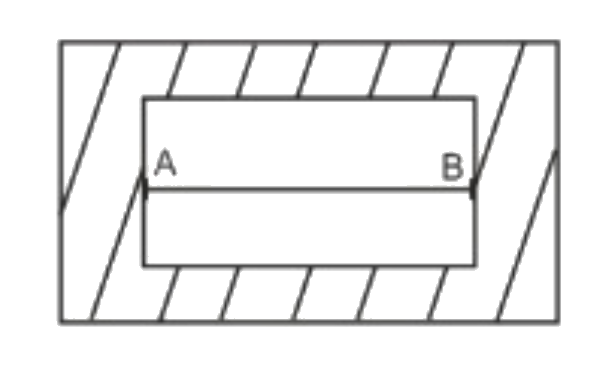A brass rod and a lead rod each 80 cm long at are clamped together at one end with their free ends coinciding. The separatioin of free ends of the rods if the system is placed in a steam bath is ( and )
0.2 mm
0.8 mm
1.4 mm
1.6 mm
The correct Answer is:B
To solve the problem of finding the separation of the free ends of a brass rod and a lead rod when placed in a steam bath, we will follow these steps:
Step 1: Understand the Problem
We have two rods, one made of brass and the other made of lead, both initially 80 cm long at 0°C. They are clamped at one end, and we need to find the separation of their free ends when the system is heated to 100°C (the temperature of the steam bath).
Step 2: Identify the Coefficients of Linear Expansion
The coefficients of linear expansion for the materials are given as:
- For brass, αbrass=18×10−6/∘C
- For lead, αlead=28×10−6/∘C
Step 3: Calculate the Change in Length for Each Rod
We will use the formula for linear expansion:
L′=L+α⋅L⋅ΔT
where:
- L′ is the final length,
- L is the initial length,
- α is the coefficient of linear expansion,
- ΔT is the change in temperature.
The initial length L for both rods is 80 cm, and the change in temperature ΔT is 100°C−0°C=100°C.
For the Brass Rod:
L′brass=80cm+(18×10−6)⋅80⋅100
Calculating:
L′brass=80+0.144cm=80.144cm
For the Lead Rod:
L′lead=80cm+(28×10−6)⋅80⋅100
Calculating:
L′lead=80+0.224cm=80.224cm
Step 4: Calculate the Separation of the Free Ends
The separation of the free ends of the rods is given by the difference in their final lengths:
Separation=L′lead−L′brass
Substituting the values we calculated:
Separation=80.224cm−80.144cm=0.08cm
Step 5: Convert to Meters (if needed)
To express the separation in meters:
0.08cm=0.0008m=8×10−4m
Final Answer
The separation of the free ends of the rods when placed in a steam bath is 0.08cm or 8×10−4m.
---
We have two rods, one made of brass and the other made of lead, both initially 80 cm long at 0°C. They are clamped at one end, and we need to find the separation of their free ends when the system is heated to 100°C (the temperature of the steam bath).
The coefficients of linear expansion for the materials are given as:
- For brass, αbrass=18×10−6/∘C
- For lead, αlead=28×10−6/∘C
We will use the formula for linear expansion:
L′=L+α⋅L⋅ΔT
where:
- L′ is the final length,
- L is the initial length,
- α is the coefficient of linear expansion,
- ΔT is the change in temperature.
L′brass=80cm+(18×10−6)⋅80⋅100
Calculating:
L′brass=80+0.144cm=80.144cm
L′lead=80cm+(28×10−6)⋅80⋅100
Calculating:
L′lead=80+0.224cm=80.224cm
The separation of the free ends of the rods is given by the difference in their final lengths:
Separation=L′lead−L′brass
Substituting the values we calculated:
Separation=80.224cm−80.144cm=0.08cm
To express the separation in meters:
0.08cm=0.0008m=8×10−4m
The separation of the free ends of the rods when placed in a steam bath is 0.08cm or 8×10−4m.
Topper's Solved these Questions
- CALORIMETRYBOOK - CENGAGE PHYSICSCHAPTER - CALORIMETRYEXERCISE - Multiple Correct
25 Videos
- CALORIMETRYBOOK - CENGAGE PHYSICSCHAPTER - CALORIMETRYEXERCISE - Comprehension
30 Videos
- CALORIMETRYBOOK - CENGAGE PHYSICSCHAPTER - CALORIMETRYEXERCISE - Subjective
25 Videos
- BASIC MATHEMATICSBOOK - CENGAGE PHYSICSCHAPTER - BASIC MATHEMATICSEXERCISE - Exercise 2.6
20 Videos
- CENTRE OF MASSBOOK - CENGAGE PHYSICSCHAPTER - CENTRE OF MASSEXERCISE - INTEGER_TYPE
1 Videos
Similar Questions
A glass rod when measured using a metal scale at 30∘C appears to be of length 100 cm. It is known that the scale was calibrated at 0∘C. Find true length of the glass rod at (a) 30∘C (b)0∘C
αsteel=8×10−6.∘C−1 and αMetal=26×10−6.∘C−1
View SolutionA metal sphere 10.01 cm in diameter is placed on a brass ring of internal diameter 10 cm and at the same temperature of 10∘C. If 100t∘C is the minimum temperature required to heat up the give system such that sphere passes through the ring. Find the value of t.
(αmetal=11.74×106/∘C and αbrass=18.002×10−6/∘C)
View Solution
Knowledge Check
A brass rod and a lead rod each 80.00 cm long at 0∘C are clamped together at one end with their free ends coinciding. The separation of the free ends of the rods it the system is placed in steam bath is (coefficients of linear expansions of brass and lead are 2×10−5/∘Cand1.0×10−5/∘C respectively)
A0.2 mmB0.8 mmC1.4 mmD1.6 mmThe length of the steel rod which would have the same difference in length with a copper rod of length 24cm at all temperatures.
(αcopper=18×10−6K−1αsteel=12×10−6k−1) is -A20 cmB18 cmC24 cmD36 cmAn iron wire AB has diameter of 0.6 mm and length 3 m at 0∘C. The wire is now stretched between the opposite walls of a brass casing at 0∘C. What is the extra tension that will be set up in the wire when the temperature of the system is raised to 40∘C?
Givne αbrass=18×10−6/K
αiron=12×10−6/K
Yiron=21×1010N/m^(2)
 A14.2 NB13.8 NC16.3 ND21.7 N
A14.2 NB13.8 NC16.3 ND21.7 N
A steel rod is 4000cm in diameter at 30∘C A brass ring has an interior diameter of 3.992cmat30∘ in order that the ring just slides onto the steel rod the common temperature of the two should be nearly (αsteel=11×10−6^(∘)Candαbrass=19×10−6^(∘)C
View SolutionThe brass scale of a barometer gives correct reading at 10∘C. The baometer reads 75cm at 30∘C. What is the a atmoshpheric pressure at o∘C(in cm Hg)
(αbrass=20×10−6/0C,λHg=175×10−6/∘C)
View SolutionA heavy brass bar has projections at its ends as shown in the figure. Two find steel wires, fastened between the projections, are just taut (zero tension) when the whole systeam is at 00C. What is the tensile stress in the steel wires when the temperature of the systeam is raised to 3000C?
Given that
αbrass=20×10−6∘C−1
αsteel=12×10−6∘C−1Ysteel=2×1011Nm−2
_E01_077_Q01.png)
View SolutionWhat must be the lengths of steel and copper rods at 0∘C for the difference in their lengths to be 10 cm at any common temperature?
(αsteel=1.2×10−5.∘K−1andαcopper=1.8×10−5.∘K−1)
View SolutionA clock is calibrated at a temperature of 20∘C Assume that the penduum is a thin brass rod of negligible mass with a heavy bob attached to the end (αbrass=19×10−6/K)
View Solution
